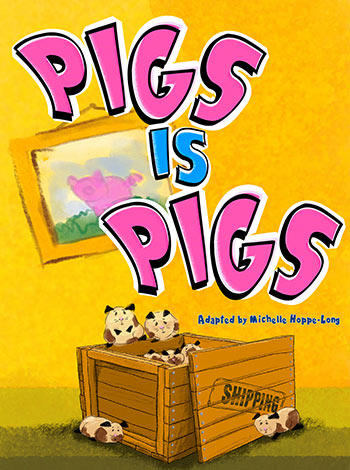Resource Guide - Pigs Is Pigs
Before the Show
Click on a topic to expand/hide content:
+ About the Show
+ The BIG Questions Before the Show
+ Activities
Animal Walks
Turn on some music and get your students moving around the room. Pick different animals such as different pets or farm animals. Encourage your students to use their whole bodies to demonstrate the animals while moving to the music.
Group Shapes
Start by asking your students to get into a big circle that fits everyone. Then let them know that you are going to ask them to make a bunch of different shapes as a group. Shapes that you have been learning about at school. Give this game an extra challenge by having the students make all of the shapes together without talking to each other. This will require them to observe what the other students are doing and think about how they can help achieve the goal.
Listening Activity
This game is similar to red-light/green-light. Have your students line up against a wall facing the other side of the room. Have a volunteer stand on the other side of the room facing away from the students. Whenever the volunteer says “pigs'' the class should quietly walk to the other side of the room, towards the volunteer. Whenever the volunteer says any other animal besides “pigs”, the students should freeze. Their goal is to make it to the wall on the other side of the room first.
+ Who wrote the story? While Children’s Theatre of Charlotte’s production of Pigs is Pigs was adapted for the stage by the talented playwright, director, and educator Michelle Hoppe-Long (pictured), the original story dates back to 1905 with a man named Ellis Parker Butler.
While Children’s Theatre of Charlotte’s production of Pigs is Pigs was adapted for the stage by the talented playwright, director, and educator Michelle Hoppe-Long (pictured), the original story dates back to 1905 with a man named Ellis Parker Butler.
Butler was the author of more than thirty books and over 2,000 short stories and essays. “Pigs is Pigs” is his most famous short story. He was a part time writer whose writing career spanned forty years. He balanced his time writing with being a full time banker. Butler was a founding member of the Author’s League of America and was a very active member of his community in New York City.
+ About the Show
When a package arrives at a rail station, an argument erupts about the contents inside. Are they pets or pigs? The station master and customer squabble over the rate to pay for purchase. “If animals come in singles or if they come in sets, if they’ve got four feet and they’re alive, they’ll be classified as pets!” This hilarious and heartwarming tale will have you doubling over with laughter.
Themes: Listening, Problem Solving, Compromise
+ The BIG Questions Before the Show
- Have you ever solved a big problem? What did you do?
- What makes a good listener? Do you think you are a good listener?
Goal LDC-2: Children participate in conversations with peers and adults in one-onone, small, and larger group interactions. Goal APL-6: Children use a variety of strategies to solve problems.
+ Activities
Animal Walks
Turn on some music and get your students moving around the room. Pick different animals such as different pets or farm animals. Encourage your students to use their whole bodies to demonstrate the animals while moving to the music.
Goal HPD-4: Children develop the large muscle control and abilities needed to move through and explore their environment.
Group Shapes
Start by asking your students to get into a big circle that fits everyone. Then let them know that you are going to ask them to make a bunch of different shapes as a group. Shapes that you have been learning about at school. Give this game an extra challenge by having the students make all of the shapes together without talking to each other. This will require them to observe what the other students are doing and think about how they can help achieve the goal.
Goal CD-12: Children identify and use common shapes and concepts about position during play and other activities. Goal APL-4: Children demonstrate creativity, imagination, and inventiveness.
Listening Activity
This game is similar to red-light/green-light. Have your students line up against a wall facing the other side of the room. Have a volunteer stand on the other side of the room facing away from the students. Whenever the volunteer says “pigs'' the class should quietly walk to the other side of the room, towards the volunteer. Whenever the volunteer says any other animal besides “pigs”, the students should freeze. Their goal is to make it to the wall on the other side of the room first.
Goal HPD-4: Children develop the large muscle control and abilities needed to move through and explore their environment. Goal APL-8: Children maintain attentiveness and focus.
+ Who wrote the story?
 While Children’s Theatre of Charlotte’s production of Pigs is Pigs was adapted for the stage by the talented playwright, director, and educator Michelle Hoppe-Long (pictured), the original story dates back to 1905 with a man named Ellis Parker Butler.
While Children’s Theatre of Charlotte’s production of Pigs is Pigs was adapted for the stage by the talented playwright, director, and educator Michelle Hoppe-Long (pictured), the original story dates back to 1905 with a man named Ellis Parker Butler.
Butler was the author of more than thirty books and over 2,000 short stories and essays. “Pigs is Pigs” is his most famous short story. He was a part time writer whose writing career spanned forty years. He balanced his time writing with being a full time banker. Butler was a founding member of the Author’s League of America and was a very active member of his community in New York City.
After the Show
Click on a topic to expand/hide content:
+ The BIG Questions After the Show
+ Activities
Pretend Store
Playing shops introduces students to basic concepts like money, price and change, as well as activities like buying, shopping, budgeting and saving. It helps them begin understanding the value of money and how to tell the difference between needs and wants. Playing shops can also be good for children’s thinking, numeracy and social skills.
You can set up a play shop using items from around your classroom or home. For example, your student could buy and sell things like:
Other things you might need to set up a play shop include:
Count items, money and change out loud. Use common money terms like dollars, amount, total, and spending.
Guess the Animal Sounds
This listening activity can be found at Plays.org . The game can be played cooperatively as a class or individually.
Farm Animal - Matching
Click the button to see a printable worksheet for your classroom or family.
Matching
+ Talk About Theatre Jobs
+ Recommended Reading
+ The BIG Questions After the Show
- Do you think the other characters were being good listeners to Mike Flannery? Do you think Mike Flannery was a good listener? How could they have listened better?
- A compromise is when two people who disagree solve their problems with an agreement that works for both of them. How did the characters in Pigs is Pigs compromise?
Goal LDC-2: Children participate in conversations with peers and adults in one-on-one, small, and larger group interactions.Goal ESD-7: Children recognize and respond to the needs and feelings of others.
+ Activities
Pretend Store
Playing shops introduces students to basic concepts like money, price and change, as well as activities like buying, shopping, budgeting and saving. It helps them begin understanding the value of money and how to tell the difference between needs and wants. Playing shops can also be good for children’s thinking, numeracy and social skills.
You can set up a play shop using items from around your classroom or home. For example, your student could buy and sell things like:
- household items like tissue boxes and toilet paper
- small toys or puzzles
- books, newspapers or magazines
- fruit and vegetables
- clothes
- plastic flowers
Other things you might need to set up a play shop include:
- labels, sticky notes or tags for sticking prices to items
- a tray or box for using as the ‘cash register’
- a notepad for writing receipts or shopping lists
- a wallet or purse for carrying money and cards
- a shelf, bookcase, table or baskets for displaying shop items
- reusable shopping bags
Count items, money and change out loud. Use common money terms like dollars, amount, total, and spending.
Goal CD-10: Children show understanding of numbers and quantities during play and other activities. Goal LDC-4: Children speak audibly and express thoughts, feelings, and ideas clearly.
Guess the Animal Sounds
This listening activity can be found at Plays.org . The game can be played cooperatively as a class or individually.
Goal CD-14: Children observe and describe characteristics of living things and the physical world.
Farm Animal - Matching
Click the button to see a printable worksheet for your classroom or family.
Matching
+ Talk About Theatre Jobs
Every play Children’s Theatre of Charlotte produces is created by a talented team of designers, technicians, actors, and a director. As a class, discuss what you experienced when you saw the performance.
- What was the first thing you noticed on the stage?
- Name three things you noticed about the scenery. Did the scenery help tell the story? What sort of scenery would you have designed?
- What did you like about the costumes? Did they fit the story? What sort of costumes would you have designed?
Goal CD-4: Children demonstrate appreciation for different forms of artistic expression. Goal LDC-2: Children participate in conversations with peers and adults in one-on-one, small, and larger group interactions.
+ Recommended Reading
If you enjoyed the show, travel to ImaginOn or your local Charlotte Mecklenburg Library branch and check out these books. Check availability at cmlibrary.org.
- Stuck in the Mud by Jane Clarke
- Shh! We Have a Plan by Chris Haughton
- The Squirrels who Squabbled by Rachel Bright
- Stuck by Oliver Jeffers

Adapted by Michelle Hoppe-Long from the story by Ellis Parker Butler





